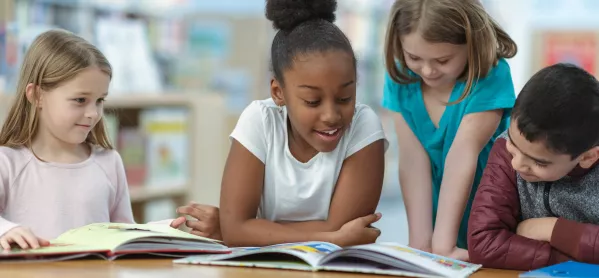How wordless books build confidence for EAL pupils

Working within Reception, there is an expectation that the pupils will learn to both read and write by the end of the academic year.
However, many children join my class with English as a second, or third, language. Therefore, my focus is to first support their speech and language development, prior to reading. I have found that using wordless books develops not only the comprehension and speech of English as an additional language children, but also the understanding of texts for confident speakers of English.
The benefits of wordless books for EAL pupils
I do this via a “guided read”, whereby, in small groups, we look together at wordless books. And this is how it works:
1. Discuss the front cover
We begin by discussing the front cover. For our EAL children, we discuss the key, often unknown, vocabulary, in addition to exploring the characters and settings. Where necessary, we provide this vocabulary in dual language, “bridging” with both English and their home language. This is incredibly important so when we discuss each page in detail later, the children have some basic vocabulary to support.
For competent speakers of English, I advance the discussion at this stage by predicting what may happen in the book and how this will involve the characters. Again, this benefits the children as they begin to understand how stories are structured and think through a story synopsis by considering the title and images on the cover.
Further reading: What’s the best way to support EAL students?
Related: Three ways to get EAL students speaking the language
In case you missed it: How to help EAL students settle into early years
2. Let students ‘pre-read’ the book and find connections
I would then give the children the chance to look through the whole book themselves, pointing out any other important vocabulary. We look together at the story structure, to help develop an understanding of introductions, problems, resolutions and endings.
By first exposing the children to the book at their own pace, they are afforded some thinking time prior to the expectation to contribute later. For all children, this also takes away the need to fiddle with the book or race ahead, as they have already seen the book in its entirety.
We also use this time prior to the “read” to discuss and relate the text to the child’s own experiences. This is so important for EAL children as often, when speaking about themselves, they are very motivated to contribute. For more able speakers of English, this allows a chance to elaborate on the similarities and differences between their experiences and those of the characters. A rich discussion can emerge by using the text as a starting point.
3 Explore and discuss the book together
Then, we look at the story together. We discuss what takes place on each page, pointing out what we see and understand to be taking place. We look especially at the small details, as I direct children to notice all the elements on the pages.
When in discussion with EAL children, I focus on very basic language structures and phrases, using the taught vocabulary in context. To help create understanding, I would point to the pictures and even encourage acting some of the scenes. Through role-play, children find it easier to explore possible speech that the characters may use with one another. For more confident speakers of English, I would encourage more detailed sentences and reasoning.

4. In-depth analysis of each page
Following the examination of a page in depth, I would summarise our work by “reading” what we have explored together. This may be two or three sentences describing the page. As I “read” the page, I would point to the relevant images that relate to the vocabulary. We would then move on to the next page and repeat the process. As the book progresses, it is important to gauge the interest of the children. I would use less emphasis on certain pages to maintain pace.
Next steps
The books are then taken home by the children and shared in their home language. After a week, I read again with them individually. During the second read, I keep the discussion quick and interesting, focusing on only a few pages. I have been fascinated at how often very specific vocabulary has been recalled, even by children who really struggle to speak English. For example, one book featured a meteorite, an alien and a tent. The child, for whom these words were completely new, recalled and used them correctly in our second read.
The benefits of wordless books are huge. The children use pictures to aid comprehension, they co-create and understand “story language”, and have the chance to explore “how?” and “why?” questions about the characters and events, as the answers are not given in text. Furthermore, pupils have the chance to use their imagination to express what is happening on the page.
When I share “low-level” phonics guided reading books instead of this first step of wordless books, the children do not think beyond what is written and need a lot of encouragement to discuss the illustrations. I have used wordless books with children from EYFS to Year 2 with great success, allowing children to think deeply and explore a text thoroughly.
Jess Gosling is a teacher at Taipei European School. She can be contacted via her website or Twitter @JessGosling2
You need a Tes subscription to read this article
Subscribe now to read this article and get other subscriber-only content:
- Unlimited access to all Tes magazine content
- Exclusive subscriber-only stories
- Award-winning email newsletters
Already a subscriber? Log in
You need a subscription to read this article
Subscribe now to read this article and get other subscriber-only content, including:
- Unlimited access to all Tes magazine content
- Exclusive subscriber-only stories
- Award-winning email newsletters